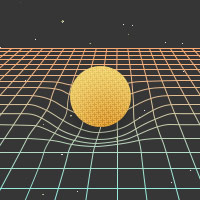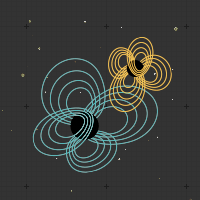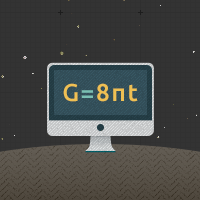GW1509014: LIGO Detects Gravitational Waves

At each L-shaped interferometer, the waves lengthened one arm of the L, pushing apart mirrors at the arm's ends by about one part in 1021, which translates into one thousandth the diameter of a proton. Simultaneously it shortened the other arm by the same amount, and then the lengthening and shortening oscillated about twelve times before dying out. The waves had passed.
A laser beam bouncing between the mirrors sensed these exquisitely tiny motions and fed its signal into a photodiode, which converted the signal from light into electric current. The current flowed through carefully designed amplifiers and circuits and then into a computer, which registered the signal and sent it through an automated data analysis program. That program produced these images, placing them on an internal LIGO website for all the scientists in the LIGO Scientific Collaboration (LSC) to see. [Note: this and the next figure are based on Figs. 1--2 in the journal article reporting this discovery.]

These pictures show the frequency of oscillation of the LIGO mirrors, plotted upward, as a function of time plotted horizontally. The mirrors are all the time oscillating just a little bit at all frequencies due to noise. The colors show the strength of the oscillation. Blue represents noise, green represents oscillations that are strong enough to likely be due to a gravitational wave, and yellow represents a very strong oscillation. At both Hanford and Livingston, the green-yellow oscillations have precisely the form that we expect for gravitational waves produced by two heavy, compact objects (black holes or neutron stars)—a compact binary—spiraling together and colliding.
The waves "chirp" upward in frequency, as time passes, in this case from about 40 Hertz (40 cycles per second) to about 260 Hertz. The signal is amazingly strong; far stronger than anyone expected for LIGO's first gravitational wave detection. And these signal shapes were identical at the two LIGO sites.
The gravitational waveform and the nature of its source
The signal was so strong that, when the scientists looked, they could see it by eye when they plotted the stretching and squeezing—the waveform—as a function of time. This was truly unexpected: the scientists had expected to have to pull their first signal out of the noise using sophisticated data analysis techniques, based in part on numerical relativity simulations. And the waveforms were the same at the two LIGO sites, aside from residual noise. The top two graphs below, based on Fig. 1 in the journal article reporting the discovery, show the gravitational-wave signals that LIGO saw.

To check to be sure that this was really a gravitational wave, the LSC/Virgo scientists extracted the incoming signal from the instrument's noise, as best they could, and they compared it with with theoretical waveforms for compact binaries that have been generated by the SXS collaboration. The observed waveforms, at the two sites, are shown in grey in the lower panels of the above figure. The width of the grey curves represent the uncertainty in the observed waveform, due to the noise. The red and blue curves represent the SXS waveform that best fits the observed waveform.
The fit is beautiful. It tells us that the source of the gravitational waveform was a pair of black holes, spiraling together, colliding, and merging into a single black hole, with one hole 36 times heavier than the sun, the other 29 times heavier than the sun, and the final hole 62 times heavier than the sun. The change from 29+36=65 solar masses to 62 solar masses tells us that the gravitational waves carried away three solar masses of energy. It is as though all the mass in three suns had been converted into pure energy and deposited into the gravitational waves! And from the SXS simulation, we learn that during the very brief collision itself, the power (the energy per unit time) being injected into the gravitational waves was greater than the total power emitted by all the stars in the universe put together. This is truly the most powerful event ever observed by humans, aside from the big bang birth of the universe itself.
Movies from computer simulations motivated by GW150914
The following are movies from computer simulations, made using the Spectral Einstein Code (SpEC). The simulations shown model the colliding black holes that produced GW150914.
Advanced LIGO saw gravitational waves from two black holes that merged over a billion light years from Earth. This computer simulation shows (in slow motion) what this would look like up close. If this movie were played back in real time, it would last for about one third of a second.
In this movie, the black holes are near us, in front of a sky filled with stars and gas and dust. The black regions are the shadows of the two black holes: no light would reach us from these areas. Light from each star or bit of gas or dust travels to our eyes along paths (light rays) that are greatly bent by the holes' gravity and by their warped spacetime. This is called "gravitational lensing." Because of this gravitational lensing, the pattern of stellar and gas/dust images changes in fascinating ways, as the black holes orbit each other, then collide and merge.
The ring around the black holes, known as an "Einstein ring," arises from all the stars in a small region directly behind the holes; gravitational lensing smears their images into the shape of a ring.
The gravitational waves themselves would not be seen by a human near the black holes (though they would be felt!) and so do not show in this video, with one important exception: The gravitational waves that are traveling outward toward the small region behind the black holes disturb that region’s stellar images in the Einstein ring, causing them to slosh around in the ring, even long after the collision. The gravitational waves traveling in other directions cause weaker, and shorter-lived sloshing, everywhere outside the Einstein ring.
Credit: SXS Lensing
Numerical simulation of two inspiraling black holes that merge to form a new black hole. Shown are the black hole horizons, the strong gravitational field surrounding the black holes, and the gravitational waves produced.
At the beginning, the visualization shows the two black holes from a distance of approx. 30,000 kilometers. The gravitational waves are depicted in orange. The black holes are surrounded by a strong gravitational field, which is visible more clearly when we zoom in. The strength of the gravitational field decreases from the inside (green) towards the outside (red). When we zoom out, the gravitational waves are visible again. The pale orange structures now appearing represent the very strong gravitational waves that are emitted along the rotational axis (perpendicular to the orbit). At the end the two black holes merge. We see the resulting black hole and the strong gravitational field (no waves).
Numerical-relativistic Simulation: S. Ossokine , A. Buonanno (Max Planck Institute for Gravitational Physics)
Scientific Visualization: W. Benger (Airborne Hydro Mapping GmbH)
This movie shows the inspiral and merger of two black holes comparable to GW150914. Shown are the horizons of the black holes as black spheres, and a representation of the warped space-time geometry as the colored surface. One hemisphere of the black hole horizons is colored, highlighting the change of rotation axis during the inspiral. The height of the colored surface illustrates curvature of space, the colors from red to green indicate how much time is slowed down near black holes, and the blue and purple colors at larger distance show gravitational waves propagating away.
Credit: SXS Collaboration/Canadian Institute for Theoretical Astrophysics/SciNet
Numerical-relativistic Simulation: S. Ossokine , A. Buonanno (Max Planck Institute for Gravitational Physics)
Scientific Visualization : R. Haas (Max Planck Institute for Gravitational Physics)
This video depicts the birth, 1.3 billion years ago, of the gravitational waves that LIGO discovered on 14 September 2015. The waves are generated by two black holes that spiral around each other, then collide and merge. In the bright green regions, the waves stretch space; in the dark green regions, they squeeze space. As the black holes near each other, the waves get stronger and the separation between them gets shorter, giving rise to a “chirp”. The two black holes collide and merge into a new black hole, bringing the waves to a crescendo. The newborn black hole vibrates briefly, then becomes quiet and stops generating waves. The waves depart from the hole’s vicinity, traveling out into the universe, carrying news of the black holes’ collision. This movie is in slow motion; if it were played back in real time, it would last for only 2/3 of a second.
For even more videos, see our GW150914 YouTube playlist!






